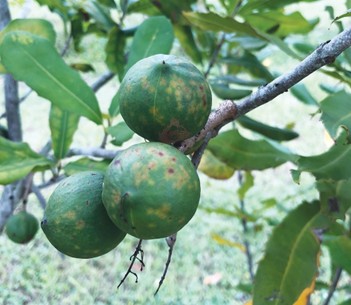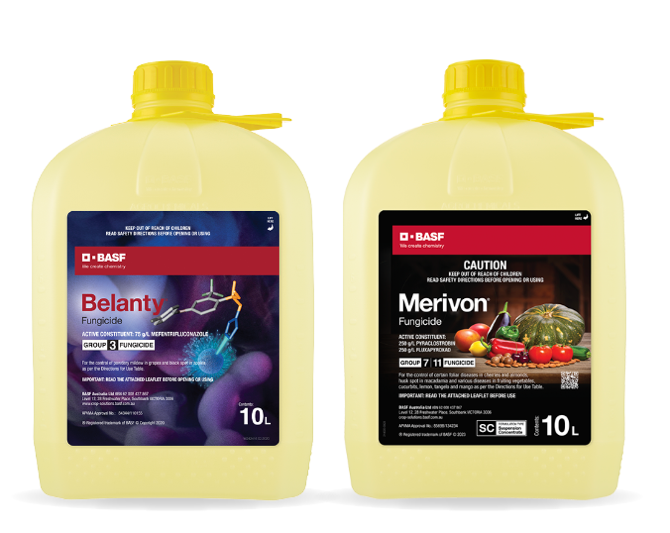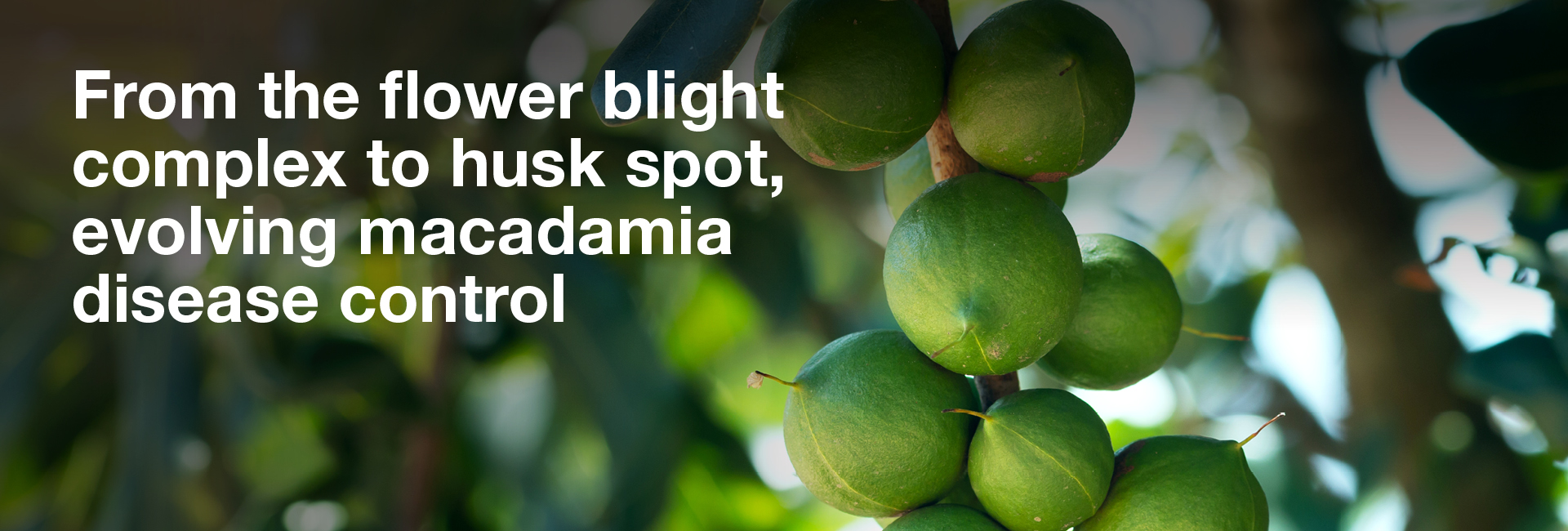In recent years there’s been a shift of focus in foliar disease management, with most macadamia growers now putting more emphasis on controlling the flower blight complex, whilst keeping on top of their husk spot control. Yet husk spot remains quite a bit more widespread than flower blight. It was ranked the second most prevalent macadamia disease behind phytophthora in the 2023 industry benchmarking report. The Flower blight complex was number three on the list, but with fifty per cent less reporting overall.
“Six or seven years ago, the flower blight complex wasn’t something people talked about — it simply wasn’t recognised,” says Mark Peacock, BASF’s Technical Development Manager for Horticulture. “Now, the industry agrees that managing it requires targeted spraying during flowering. That’s a positive shift, but it also highlights the importance of following up with effective husk spot control. Once you’ve reduced nut drop, you have more yield worth protecting.”
Mark thinks that growers have probably been reluctant to spend as much as they arguably should on a complete fungicide program while macadamia prices were relatively low. Now that the prices are rebounding, he hopes growers will see the value in controlling husk spot as effectively as possible, especially since they now have the best product yet to help them.
“If you go back a decade, everyone was using Cabrio® on husk spot,” he explains. “Since then, there’s been incremental improvement. Merivon® took over as the hero product and now Belanty® has come along. Based on the data, Belanty is the best-performing product we’ve ever tested for husk spot.”
The latest step up in performance continues a steady improvement, but the way Belanty achieves its superior control is a very important change. Belanty is a next-generation Group 3 fungicide. The fungicides with that mode of action are all classed as triazoles, but Belanty is a bit different to the others. It is the first ‘isopropanol-azole’, with a flexible hybrid molecule that binds more strongly to the target sites of fungal pathogens, including those that have developed resistance to standard Group 3 fungicides.
So Belanty is both an upgrade on older triazoles and a change in the preferred mode of action for tackling husk spot. Cabrio has the Group 11 mode of action and Merivon has
the same Group 11 active ingredient as Cabrio co-formulated with an advanced Group 7 active. That means the registration of Belanty makes the fungicide rotation for macadamia protection more diverse and sustainable in the long term as well as more effective right now.
Mark points out that the timing of Belanty’s introduction to macadamia spray programs couldn’t have been better. Now that Merivon has been registered to control the flower blight complex and is predominantly used earlier in the season, growers are turning to Belanty as the lead treatment for husk spot and can expect to get better results than ever.
“Husk spot was probably a lesser focus there for a while,” he says, “but it hasn’t gone away. If anything, I’d say it has become worse and more widespread. So once people have looked after the crop through flowering, we think they need to be spraying Belanty at match head and then again three weeks later – the same timings they may have used for Merivon in the past.”

Source: Jeremy Bright, Development Officer - Macadamia, NSW DPIRD.
Now that Merivon is registered for the whole flower blight complex, growers can use it twice in the early window, starting before the rachis is fully elongated with a follow-up when the flowers are fully opened. Merivon can be used up to three times in any one season, so it can still also be used after two sprays of Belanty for husk spot if the disease pressure is very high or persistent.
Mark emphasises the value of protecting the yield gains achieved through early Merivon sprays by following up with Belanty. “If you’re investing in flowering protection, it makes no sense to ignore husk spot — managing both is key to maximising value.”
Macadamia growers were already familiar with its use later in the season to control husk spot, so those who know all about the potential of flower blight to cause massive yield losses have been quick to take full advantage of the added registrations.
“We’ve had tremendous uptake,” Mark says. “Obviously we’ve been able to do demonstration trials and people knew the product from using it on husk spot. But I think mainly a lot of growers have been struggling with flower blight for years, so once they had that new window to use Merivon in they took it up pretty quickly.”
Mark stresses that the application needs to be early to get the best results. “You really need to make the first spray as close as possible to the flower racemes emerging to get the best possible protection. If you get it early, you’ll stop the disease developing much more effectively than if you sprayed even a couple of weeks later.”
The directions for use on the Merivon label specify that the first application for any form of the flower blight complex should be before flowering stage 1, that is before the rachis is fully elongated. That can be followed by a second spray if it’s needed at stage 3, when the flowers are fully opened. Merivon shouldn’t be used more than three times in any one season, so Mark advises growers who have been relying on it for husk spot control to start the program for that disease with Belanty instead. Belanty is from Group 3, so that introduces a third mode of action that can be used twice before rotating back to Merivon for a third and final husk spot spray if it’s needed.
The reason why Mark thinks it’s important to prioritise using Merivon on the flower blight complex is that reliable control has been so difficult to achieve in the past. Now that there’s such an effective treatment available for such a potentially damaging disease, he’s sure it pays to be proactive. “Merivon is basically an insurance policy,” he concludes, “because you can’t do anything about the flower blight complex if you haven’t taken action by the time symptoms start to appear.”

For more information about Merivon® and Belanty® speak to your local BASF representative or visit crop-solutions.basf.com.au
ALWAYS READ AND FOLLOW LABEL DIRECTIONS.
The information submitted in this publication is based on current BASF knowledge and experience.
© Copyright BASF 2025 ® Registered trademark of BASF. AU55-P00001997 0725
